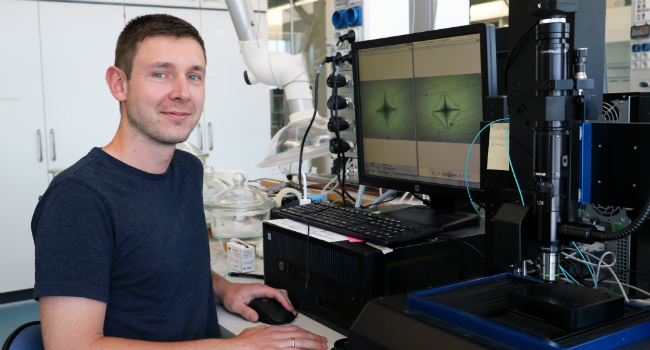A new type of glass with self-healing properties and superior crack resistance has just been developed by researchers at Aalborg University (AAU). Glass materials is a research area with great potential, but also many unknowns. The new understanding of how to reduce the brittleness of glass and improve glass flexibility paves the way for cracks in smartphone screens, scratches on eyeglasses and chips in car windshields to perhaps soon be a thing of the past. A solution that also emerged from a somewhat unlikely source.
‘Although we don’t think about this in everyday life, glass is actually not particularly fond of water, especially when it comes to cracking. Most of us have probably experienced a stone hitting the car windshield. What starts out looking like a small chip can eventually develop into a slowly growing crack. What happens is that water molecules from humid air break down the glass network and make the crack grow,’ says Kacper Januchta, Aalborg University.
Kacper Januchta is a PhD student in the Department of Chemistry and Biosciences at Aalborg University and first author of the article just published in the premium journal Advanced Science.
Unlike ordinary glass, the newly developed type of glass from Aalborg University has the special characteristic of water having a positive effect on the crack resistance of the material; indentations and scratches in the surface do not grow, but instead become smaller over time.
Breakthrough with great potential
The glass researchers’ breakthrough is a stunning result and must be viewed as foundational work with great potential in the field of glass science.
‘We’ve gained completely new insight into the mechanisms affecting the formation of cracks in glass and thus also how it can be avoided. The next steps are now to implement some of these same mechanisms in glass products that already exist on the market, says Morten Mattrup Smedskjaer, Professor with special responsibilities at AAU and head of the research project.
If the brittleness of glass can be significantly improved as a result of this breakthrough, this could mean significantly thinner glass in windows and car windshields. Since glass materials are produced at very high temperatures, producing and transporting thinner glass can potentially translate into energy savings and reduced CO2 emissions.
Facts:
The project is funded by VILLUM FONDEN, and includes Malwina Stepniewska, PhD student; Yuanzheng Yue, Professor; and Lars R. Jensen, Associate Professor, all of AAU; Yang Zhang, Senior Researcher and Marcel A. J. Somers, Professor, both of the Technical University of Denmark; and Mathieu Bauchy, Assistant Professor, UCLA, USA.
Read the scientific article here: https://onlinelibrary.wiley.com/doi/full/10.1002/advs.201901281
Contact:
Morten Mattrup Smedskjær, Professor with special responsibilities, Tel.: +45 5142 7672, mos@bio.aau.dk
Kacper Januchta, PhD student, Tel.: +45 4166 4585, kja@bio.aau.dk
Press contact: Camilla Kristensen, Tel.: +45 9940 9905, cakr@bio.aau.dk
Press contact: Hiva Ahmadi, Tel.: +45 2220 6860, hiah@adm.aau.dk

